How do I stop Starlings, Grackles and Blackbirds*?
These species can inundated many a backyard feeder. European Starlings (Sturnus vulgaris) are a non-native species and are not related to our native blackbirds. They are iridescent black with speckles. Their beaks are dark in winter and yellow in summer (shown below) .
Common Grackles (Quiscalus quiscula), who are black with a purple-blue sheen to their heads and black beaks, are our most common blackbirds. Red-winged Blackbirds (Agelaius phoeniceus) and Brown-headed Cowbirds (Molothrus ater) are other native blackbirds who may visit your feeders.
*While not technically correct, all three species are commonly lumped under the term "Blackbird," and for simplicity we will use the term throughout the article unless specific clarification needs to be made.
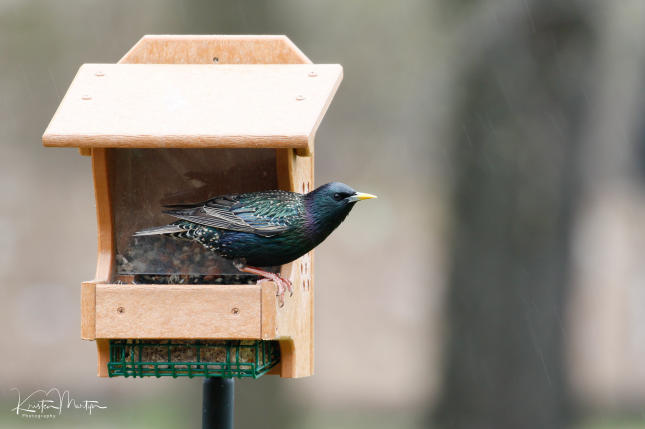
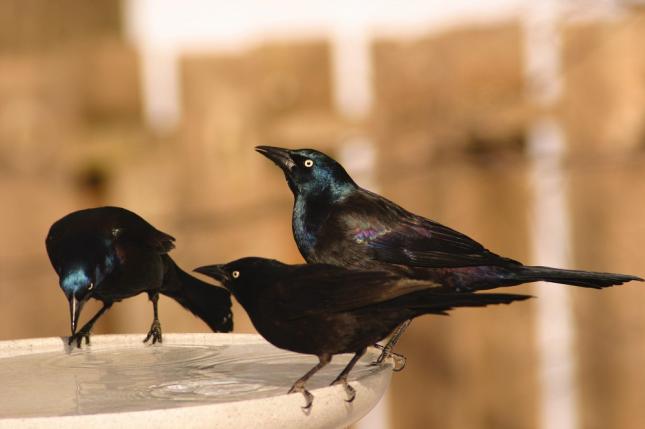
European Starlings (Sturnus vulgaris) - Left, Photo by Kristen Martyn
Common Grackles (Quiscalus quiscula) - Right
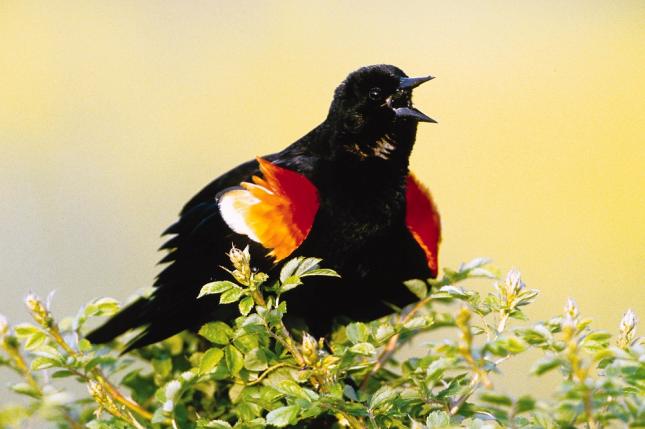
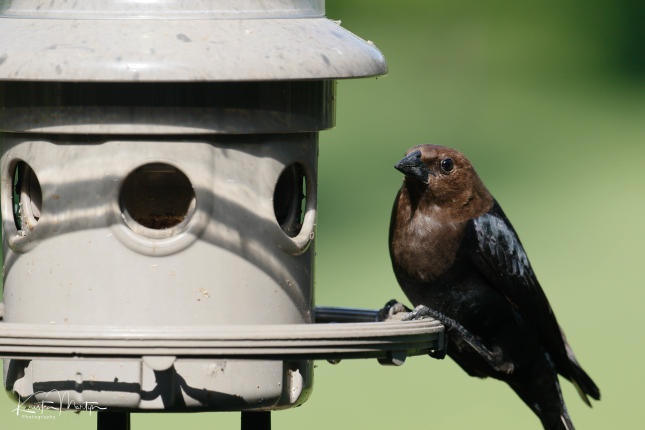
Red-winged Blackbirds (Agelaius phoeniceus) - Left
Brown-headed Cowbirds (Molothrus ater) - Right, Photo by Kristen Martyn
European Starlings' preferred diet consists primarily of insects and berries, but if these are hard to find, they turn to our feeders instead. Their beaks are not designed for cracking hard seed shells, so they go first for the softer suet cakes, peanuts, and other foods without shells. If those aren't available, they will even force themselves to eat hard shelled seeds. Fortunately, we do have a few tricks to eliminate Starlings from some feeders, and to slow them down at others, so your other birds can get their share of food, too.
The other blackbirds are more traditional seed eaters. They are less likely to bother suet, unless it is of poor quality (i.e. filled with seeds or grains), but will devour most common seeds readily.
Here are our 3 Rules for Keeping out Starlings and Blackbirds
1. Offer Foods with Less Appeal: There are a few foods which are less palatable to blackbirds and using these in feeders that don't have guards on them can help discourage these birds from taking over.
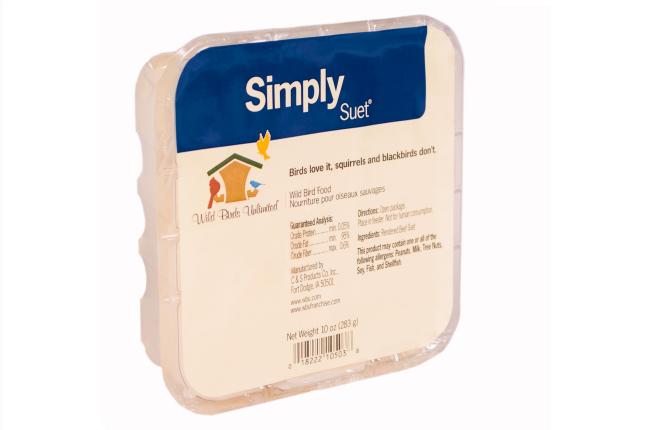 WBU Simply Suet®: WBU Simply Suet® does not have much appeal to European Starlings. Only now and then do we hear of starlings eating them, usually out of complete desperation; but we hear many great success stories from many people who come back to buy more, having had no starlings bother them at all. An added bonus is that squirrels don't care much for WBU Simply Suet® either!
WBU Simply Suet®: WBU Simply Suet® does not have much appeal to European Starlings. Only now and then do we hear of starlings eating them, usually out of complete desperation; but we hear many great success stories from many people who come back to buy more, having had no starlings bother them at all. An added bonus is that squirrels don't care much for WBU Simply Suet® either!
We recommending using our WBU SuperSuet in a caged suet feeder or upside down suet feeder (shown below) since this suet has the best overall appeal to woodpeckers, and our WBU Simply Suet® in our WBU EcoTough® Double Tail Prop Suet Feeder for Pileated Woodpeckers for any larger woodpeckers that choose not to stretch into the cage. This dual approach keeps everyone happy.

Safflower Seed: Sunflower-eating birds love safflower; squirrels and blackbirds typically don’t. If you are looking to be more exclusive with your bird feeding, safflower may be the solution for you. Many of your favorite birds will enjoy safflower, yet blackbirds, grackles and squirrels typically don't. Safflower can be offered in hopper, platform or tube feeders, and it is especially helpful for window or deck feeders where blackbirds or squirrels may be a problem. Offer safflower gradually, mixing it with the seed blends you currently provide, and over time, you'll end up with a dining spot for all kinds of birds, including House Finches, woodpeckers, nuthatches and chickadees.
Bag Sizes: 5 lbs. (2.26 kg ), 10 lbs. (4.53 kg), 20 lbs. (9.07 kg) and 50 lbs. (22.67 kg)
 Peanuts in the Shell: Since European Starlings lack the beak strength to crack hard peanut shells, whole peanuts can successfully attract jays, woodpeckers, nuthatches and a few other species without encouraging starlings. About the only time we see starlings bother whole peanuts is if a woodpecker picks apart a shell and flies off with one peanut kernel, leaving the other kernel exposed, or if a batch of peanuts arrives with very thin or already cracked shells. Try peanuts in the shell in a number of interesting feeders. Peanuts are the best single source of protein and fat for your birds and a great addition to the choices you offer in your yard. We pride ourselves on being a one-stop bird feeding shop, not only offering bird feeders but also food to fill them. Peanuts in the shell are typically used for feeding squirrels and some of the larger billed birds such as jays. Titmice also enjoy peanuts in the shell. Use our peanuts in the shell in your peanut feeders to provide the energy that birds need.
Peanuts in the Shell: Since European Starlings lack the beak strength to crack hard peanut shells, whole peanuts can successfully attract jays, woodpeckers, nuthatches and a few other species without encouraging starlings. About the only time we see starlings bother whole peanuts is if a woodpecker picks apart a shell and flies off with one peanut kernel, leaving the other kernel exposed, or if a batch of peanuts arrives with very thin or already cracked shells. Try peanuts in the shell in a number of interesting feeders. Peanuts are the best single source of protein and fat for your birds and a great addition to the choices you offer in your yard. We pride ourselves on being a one-stop bird feeding shop, not only offering bird feeders but also food to fill them. Peanuts in the shell are typically used for feeding squirrels and some of the larger billed birds such as jays. Titmice also enjoy peanuts in the shell. Use our peanuts in the shell in your peanut feeders to provide the energy that birds need.
Bag Sizes: 3 lbs. (1.36 kg), 6 lbs. (2.72 kg) and 30 lbs. (14 kg)
Grackles CAN crack peanut shells, so this advice applies only to starlings.
 Nyjer® (Thistle) Seed: Nyjer® (thistle) is finches' favorite food. Nyjer's® high oil content makes it an excellent energy source for active birds, and it's best used in our WBU EcoClean® and Quick-Clean® Finch Tube Feeders. Since our WBU Finch Feeders have small holes for finch sized beaks access to the Nyjer® is near impossible for starlings and blackbirds; but the little birds such as American Goldfinches, House Finches, Purple Finches, Indigo Buntings, Pine Siskins, Redpolls and Black-capped Chickadees can access the food.
Nyjer® (Thistle) Seed: Nyjer® (thistle) is finches' favorite food. Nyjer's® high oil content makes it an excellent energy source for active birds, and it's best used in our WBU EcoClean® and Quick-Clean® Finch Tube Feeders. Since our WBU Finch Feeders have small holes for finch sized beaks access to the Nyjer® is near impossible for starlings and blackbirds; but the little birds such as American Goldfinches, House Finches, Purple Finches, Indigo Buntings, Pine Siskins, Redpolls and Black-capped Chickadees can access the food.
FEEDING TIP: Never offer bread, pizza crusts, or other similar foods. Few songbirds will eat them, yet these soft foods are extremely palatable to starlings and will act like a magnet, drawing every starling in the neighborhood.
2. Exclude Them! The most effective way to avoid losing all your bird food to starlings and blackbirds is to physically prevent them from gaining access to the food. These birds are simply too large to fit through the openings of the cages that surround the feeders below, yet smaller birds fly right through the openings in much the same way as they would fly through a fence or navigate in the dense branches of a bush. Even the larger woodpeckers can still feed thanks to their long necks, prying beaks, and agile tongues, which can stretch to obtain food. These cages will also stop squirrels and quickly pay for themselves in terms of food saved.
NOTE: Cages should have a diameter of 11” to avoid grackles and starlings eating the food by sticking their necks through the bars of the cage.
NOTE: Cages with 1½” mesh do not work to keep Red Squirrels or Eastern Chipmunks out. They can fit through the bars of the cage and are too light to trigger many squirrel proof bird feeders. Please see out section on Stopping Red Squirrels and Stopping Eastern Chipmunks if you have these visitors in your yard.
 WBU Tube Feeder Cages: Add a WBU Tube Feeder Cage to our WBU Seed Tube Feeders, WBU Finch Feeders and WBU Peanut Feeders to protect the food from squirrels and larger birds. Cages feature a 1.5 inch by 1.5 inch mesh and are easy to install. Cages are available in two colours green and black. "On-Guard" Cages can fit over a variety of feeders and utilize 1½” openings which allow smaller birds to feed, but exclude European Starlings, Common Grackles and Eastern Gray Squirrels. These are perfect for deck rail feeding or for when the arrangement of trees in a yard won't allow the use of baffles.
WBU Tube Feeder Cages: Add a WBU Tube Feeder Cage to our WBU Seed Tube Feeders, WBU Finch Feeders and WBU Peanut Feeders to protect the food from squirrels and larger birds. Cages feature a 1.5 inch by 1.5 inch mesh and are easy to install. Cages are available in two colours green and black. "On-Guard" Cages can fit over a variety of feeders and utilize 1½” openings which allow smaller birds to feed, but exclude European Starlings, Common Grackles and Eastern Gray Squirrels. These are perfect for deck rail feeding or for when the arrangement of trees in a yard won't allow the use of baffles.
Cage Dimensions: 13” x 18” with a 13" Diameter
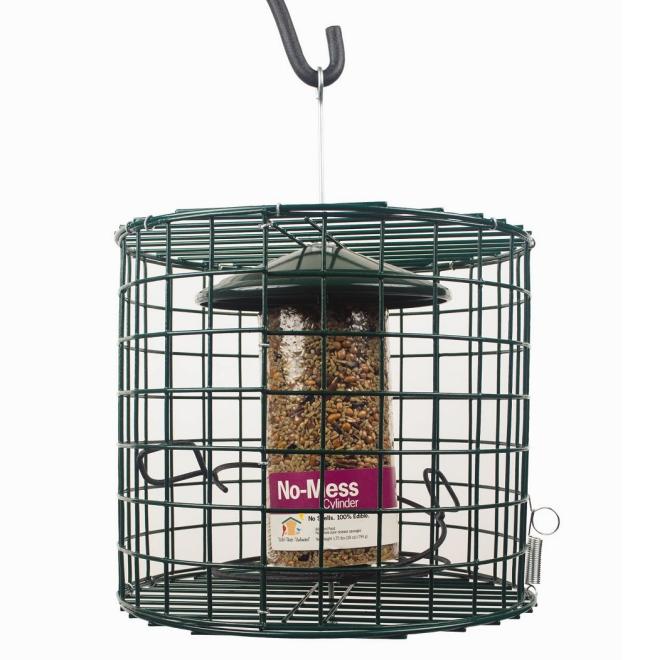 WBU Seed Cylinder Cage: Add a WBU Seed Cylinder Cage to our WBU Seed Cylinder Bird Feeder to protect the food from squirrels and larger birds. Cages feature a 1.5 inch by 1.5 inch mesh and are easy to install. "On-Guard" Cages can fit over a variety of feeders and utilize 1½” openings which allow smaller birds to feed, but exclude European Starlings, Common Grackles and Eastern Gray Squirrels. These are perfect for deck rail feeding or for when the arrangement of trees in a yard won't allow the use of baffles.
WBU Seed Cylinder Cage: Add a WBU Seed Cylinder Cage to our WBU Seed Cylinder Bird Feeder to protect the food from squirrels and larger birds. Cages feature a 1.5 inch by 1.5 inch mesh and are easy to install. "On-Guard" Cages can fit over a variety of feeders and utilize 1½” openings which allow smaller birds to feed, but exclude European Starlings, Common Grackles and Eastern Gray Squirrels. These are perfect for deck rail feeding or for when the arrangement of trees in a yard won't allow the use of baffles.
Cage Dimensions: 11” x 13” diameter
 WBU Starling Proof Suet/Peanut Feeder: The WBU Starling Proof Sue/Peanut Feeder is designed to make it impossible for large birds and squirrels to eat your suet and no-melt dough cakes; but can also be used to offer smaller birds peanuts in the shell. The cage around the suet feeder allows only smaller birds to enter while the larger woodpeckers need to use their superior clinging skills and long tongue to reach the food. Grackles and starlings cannot feed from this feeder. The WBU Starling Proof Suet Feeder accommodates 3 suet or no-melt dough cakes and whole peanuts (in the shell).
WBU Starling Proof Suet/Peanut Feeder: The WBU Starling Proof Sue/Peanut Feeder is designed to make it impossible for large birds and squirrels to eat your suet and no-melt dough cakes; but can also be used to offer smaller birds peanuts in the shell. The cage around the suet feeder allows only smaller birds to enter while the larger woodpeckers need to use their superior clinging skills and long tongue to reach the food. Grackles and starlings cannot feed from this feeder. The WBU Starling Proof Suet Feeder accommodates 3 suet or no-melt dough cakes and whole peanuts (in the shell).
 WBU Finch Feeders: WBU EcoClean® and Quick-Clean® Finch Feeders, also called Nyjer® Feeders, are feeders designed specifically for finches and for finch food. Finch Tube Feeders differ from seed tube feeders in that the holes are small enough to accommodate finch beaks, preventing other birds, chipmunks and squirrels from feeding. Our WBU Finch Feeders accommodate Nyjer® seed and our finch blends. Many birds enjoy using WBU Finch Feeders including: American Goldfinches, House Finches, Purple Finches, Indigo Buntings, Pine Siskins, Redpolls and Black-capped Chickadees. The small holes on our WBU EcoClean® and Quick-Clean® Finch Feeders prevent squirrels from accessing the food.
WBU Finch Feeders: WBU EcoClean® and Quick-Clean® Finch Feeders, also called Nyjer® Feeders, are feeders designed specifically for finches and for finch food. Finch Tube Feeders differ from seed tube feeders in that the holes are small enough to accommodate finch beaks, preventing other birds, chipmunks and squirrels from feeding. Our WBU Finch Feeders accommodate Nyjer® seed and our finch blends. Many birds enjoy using WBU Finch Feeders including: American Goldfinches, House Finches, Purple Finches, Indigo Buntings, Pine Siskins, Redpolls and Black-capped Chickadees. The small holes on our WBU EcoClean® and Quick-Clean® Finch Feeders prevent squirrels from accessing the food.
Our WBU Finch Feeder Models which discourage squirrels and chipmunks include:
- WBU EcoClean® Medium Finch Tube Feeder
- WBU EcoClean® Small Finch Tube Feeder
- WBU Large Quick-Clean™ Finch Feeder
- WBU Medium Quick-Clean™ Finch Feeder
3. Slow Them Down: There are a few feeders and accessories worth mentioning that starlings and blackbirds can use, but which are challenging enough that the starlings and blackbirds may not completely dominate.
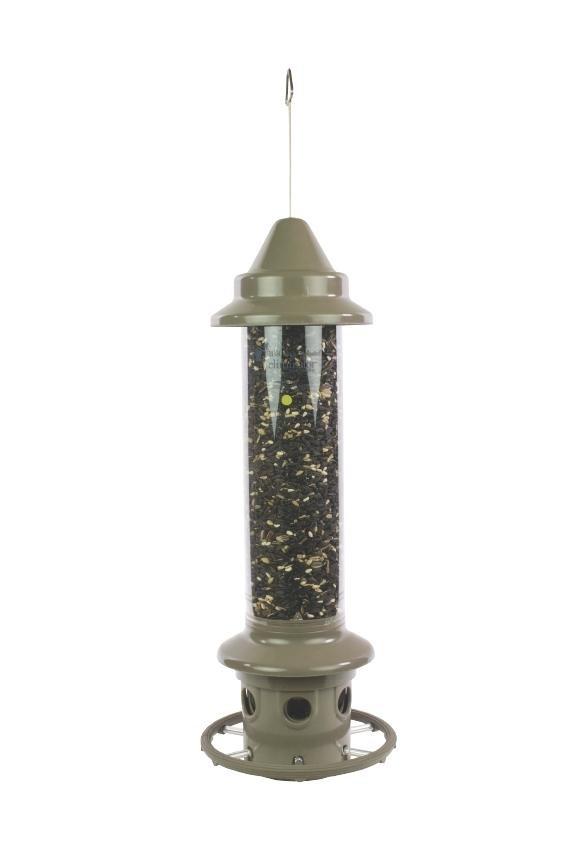 WBU Eliminator: Protect your bird seed bounty from squirrels with our WBU Eliminator bird feeder. When a squirrel touches the perch ring, its weight closes the seed ports, foiling its seed-stealing plot. The WBU Eliminator's unique technology allows you to set the sensitivity level, so you can also exclude large birds such as pigeons or doves. The tension setting can also be used to keep out the lighter Red Squirrel. This feeder can be hung or pole mounted using the WBU Eliminator Squirrel Proof Bird Feeder Pole Adapter Assembly Kit (sold separately- see description below). The WBU Eliminator Squirrel Proof Bird Feeder Pole Adapter Assembly Kit (sold separately) allows the Eliminator to be mounted on a WBU Advanced Pole System® (APS) (sold separately). The WBU Eliminator has a capacity for approximately 3 lbs. (1.36 kg) or 14 cups of seed. The WBU Eliminator weighs approximately 3.2 lbs. (1.45 kg) unfilled and 6.2 lbs. filled (2.81 kg). If a tree were to hold this feeder, it would have to be a very sturdy tree. This feeder also features a special seed ventilation system that helps keep seed fresher. The WBU Eliminator can be disassembled and assembled with no tools, and all of its parts are top shelf dishwasher safe. The WBU Eliminator is available in gray or green. This feeder is backed by a limited lifetime guarantee.
WBU Eliminator: Protect your bird seed bounty from squirrels with our WBU Eliminator bird feeder. When a squirrel touches the perch ring, its weight closes the seed ports, foiling its seed-stealing plot. The WBU Eliminator's unique technology allows you to set the sensitivity level, so you can also exclude large birds such as pigeons or doves. The tension setting can also be used to keep out the lighter Red Squirrel. This feeder can be hung or pole mounted using the WBU Eliminator Squirrel Proof Bird Feeder Pole Adapter Assembly Kit (sold separately- see description below). The WBU Eliminator Squirrel Proof Bird Feeder Pole Adapter Assembly Kit (sold separately) allows the Eliminator to be mounted on a WBU Advanced Pole System® (APS) (sold separately). The WBU Eliminator has a capacity for approximately 3 lbs. (1.36 kg) or 14 cups of seed. The WBU Eliminator weighs approximately 3.2 lbs. (1.45 kg) unfilled and 6.2 lbs. filled (2.81 kg). If a tree were to hold this feeder, it would have to be a very sturdy tree. This feeder also features a special seed ventilation system that helps keep seed fresher. The WBU Eliminator can be disassembled and assembled with no tools, and all of its parts are top shelf dishwasher safe. The WBU Eliminator is available in gray or green. This feeder is backed by a limited lifetime guarantee.
- Dimensions Feeder: 28½" x 8" Diameter
- Dimensions Tube: 21¼" x 4½" Diameter
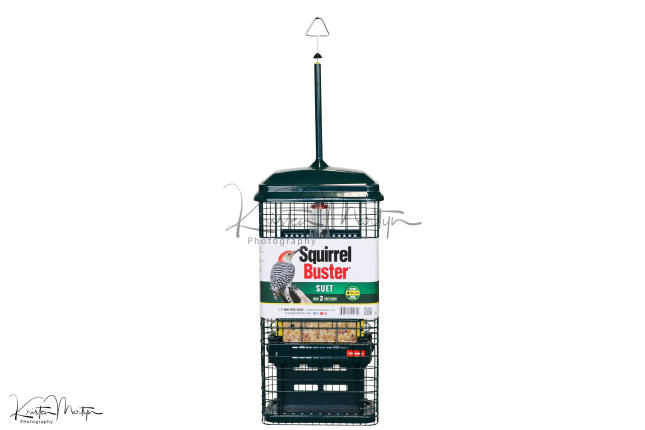 Squirrel Buster Suet: The Squirrel Buster Suet continues to raise the standard in everything a wild bird feeder should be, now for suet! The Squirrel Buster Suet is weight adjustable and has a closing mechanism that shuts out squirrels as well as some of the heavier and undesirable birds. No suet is wasted! Crumbs fall to the Crumb Port where birds recycle them. These savings alone pay for the feeder. Easy to fill and hang, the Squirrel Buster Suet holds two 5” x 5” WBU Suet Cakes. The Squirrel Buster Suet can be disassembled and assembled with no tools for easy cleaning and filling, and offers grease free filling for less mess!
Squirrel Buster Suet: The Squirrel Buster Suet continues to raise the standard in everything a wild bird feeder should be, now for suet! The Squirrel Buster Suet is weight adjustable and has a closing mechanism that shuts out squirrels as well as some of the heavier and undesirable birds. No suet is wasted! Crumbs fall to the Crumb Port where birds recycle them. These savings alone pay for the feeder. Easy to fill and hang, the Squirrel Buster Suet holds two 5” x 5” WBU Suet Cakes. The Squirrel Buster Suet can be disassembled and assembled with no tools for easy cleaning and filling, and offers grease free filling for less mess!
See the Squirrel Buster Suet Brochure for assembly and cleaning information.
Dimensions: 8.68” x 4.45” x 18.63”
Weight: 3.74 lbs.
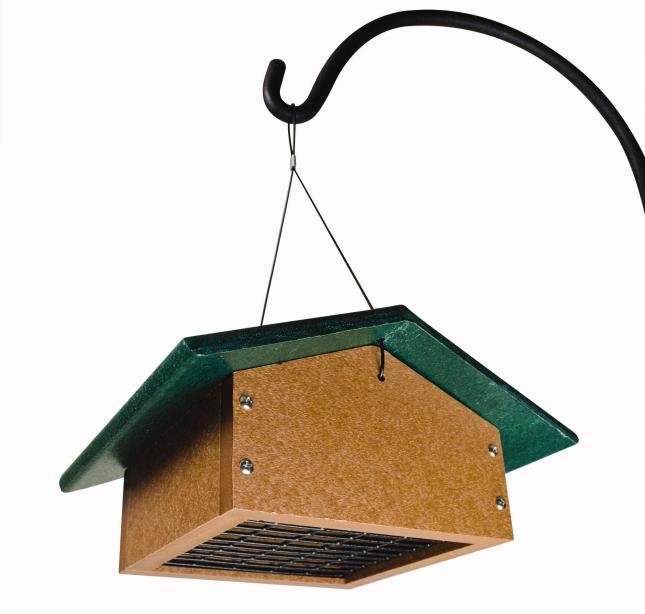 WBU EcoTough® Upside Down Suet Feeder: There are quite a few books and magazines that claim Starlings can't hang up-side down like the woodpeckers. Well, the starlings didn't read those articles and we'll be the first to say the WBU EcoTough® Upside Down Suet Feeder is not foolproof. However, the challenge of accessing food from only the bottom of this feeder may be enough to keep starlings from eating an entire suet cake in one sitting. So, if you don't care for the look of the cage style protectors above, this feeder may be helpful.
WBU EcoTough® Upside Down Suet Feeder: There are quite a few books and magazines that claim Starlings can't hang up-side down like the woodpeckers. Well, the starlings didn't read those articles and we'll be the first to say the WBU EcoTough® Upside Down Suet Feeder is not foolproof. However, the challenge of accessing food from only the bottom of this feeder may be enough to keep starlings from eating an entire suet cake in one sitting. So, if you don't care for the look of the cage style protectors above, this feeder may be helpful.
Dimensions: 10½” x 8” x 9”
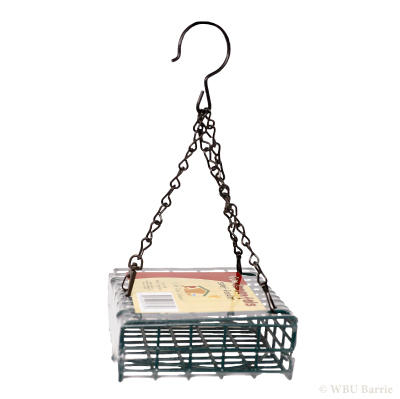 Starling Stumper: The Starling Stumper is an easy way to help keep starlings and blackbirds out of your suet feeder. The Starling Stumper features a center hanger attached to three 6" chains. Snaps on the ends of the chains secure the Starling Stumper to your feeder. The two small snaps attach to corners of a WBU Suet Feeder and a third swivel snap keeps the door closed and provides access to the food for easy refilling. Leave plastic container from your WBU Suet Cakes on the food and place it in cage with suet facing down. The woodpeckers, chickadees, nuthatches and other suet eating birds can cling from the bottom and feed upside down; but the larger blackbirds and starlings are more uncomfortable feeding this way. The Starling Stumper will work with most sizes and shapes of suet cages. Read this article about upside down suet feeding in the Nature Notes Blog for more inspiration: http://naturenotesblog.blogspot.ca/2014/05/diy-upsidedown-suet-feeder.html
Starling Stumper: The Starling Stumper is an easy way to help keep starlings and blackbirds out of your suet feeder. The Starling Stumper features a center hanger attached to three 6" chains. Snaps on the ends of the chains secure the Starling Stumper to your feeder. The two small snaps attach to corners of a WBU Suet Feeder and a third swivel snap keeps the door closed and provides access to the food for easy refilling. Leave plastic container from your WBU Suet Cakes on the food and place it in cage with suet facing down. The woodpeckers, chickadees, nuthatches and other suet eating birds can cling from the bottom and feed upside down; but the larger blackbirds and starlings are more uncomfortable feeding this way. The Starling Stumper will work with most sizes and shapes of suet cages. Read this article about upside down suet feeding in the Nature Notes Blog for more inspiration: http://naturenotesblog.blogspot.ca/2014/05/diy-upsidedown-suet-feeder.html
 Large Tray Hanger: The Large Tray Hanger is a chain hanger that can be attached to wooden trays using eye-screws (not included) or a WBU Suet Feeder to flip upside down as a blackbird deterrent. The hanger comes complete with 4 chains 13” long. The Large Tray Hanger comes complete with a center hanger and snaps on for easy assembly to trays. Leave plastic container from your WBU Suet Cakes on the food and place it in the feeder with suet facing down. The woodpeckers, chickadees, nuthatches and other suet eating birds can cling from the bottom and feed upside down; but the larger blackbirds and starlings are more uncomfortable feeding this way. The Large Tray Hanger will work with most sizes and shapes of suet cages. Read this article about upside down suet feeding in the Nature Notes Blog for more inspiration: http://naturenotesblog.blogspot.ca/2014/05/diy-upsidedown-suet-feeder.html
Large Tray Hanger: The Large Tray Hanger is a chain hanger that can be attached to wooden trays using eye-screws (not included) or a WBU Suet Feeder to flip upside down as a blackbird deterrent. The hanger comes complete with 4 chains 13” long. The Large Tray Hanger comes complete with a center hanger and snaps on for easy assembly to trays. Leave plastic container from your WBU Suet Cakes on the food and place it in the feeder with suet facing down. The woodpeckers, chickadees, nuthatches and other suet eating birds can cling from the bottom and feed upside down; but the larger blackbirds and starlings are more uncomfortable feeding this way. The Large Tray Hanger will work with most sizes and shapes of suet cages. Read this article about upside down suet feeding in the Nature Notes Blog for more inspiration: http://naturenotesblog.blogspot.ca/2014/05/diy-upsidedown-suet-feeder.html
 Recycled Hanging Mealworm Feeder: The Recycled Hanging Mealworm Feeder is a great way to offer mealworms to a variety of birds including bluebirds, woodpeckers, chickadees, nuthatches, cardinals and wrens. Place a single layer of mealworms, roasted mealworms or Birdacious® Bark Butter Bits on the floor of the feeder. Birds will feed inside the feeder by entering from either end of the feeder. The hole size helps to keep out larger more aggressive birds such as starlings and jays from feeding. The Recycled Hanging Mealworm Feeder is made from recycled milk jugs and features a heavy acrylic window for easy viewing. Simply lift the hinged roof for easy filling. This feeder can be hung or mounted on a pole mounted.
Recycled Hanging Mealworm Feeder: The Recycled Hanging Mealworm Feeder is a great way to offer mealworms to a variety of birds including bluebirds, woodpeckers, chickadees, nuthatches, cardinals and wrens. Place a single layer of mealworms, roasted mealworms or Birdacious® Bark Butter Bits on the floor of the feeder. Birds will feed inside the feeder by entering from either end of the feeder. The hole size helps to keep out larger more aggressive birds such as starlings and jays from feeding. The Recycled Hanging Mealworm Feeder is made from recycled milk jugs and features a heavy acrylic window for easy viewing. Simply lift the hinged roof for easy filling. This feeder can be hung or mounted on a pole mounted.
 Hanging Mealworm Feeder: The Hanging Mealworm Feeder is a great way to offer mealworms to a variety of birds including bluebirds, woodpeckers, chickadees, nuthatches, cardinals and wrens. Place a single layer of mealworms, roasted mealworms or Birdacious® Bark Butter Bits on the floor of the feeder. Birds will feed inside the feeder by entering from either end of the feeder. The hole size helps to keep out larger more aggressive birds such as starlings and jays from feeding. Simply lift the hinged roof for easy filling. This feeder can be hung or mounted on a pole mounted.
Hanging Mealworm Feeder: The Hanging Mealworm Feeder is a great way to offer mealworms to a variety of birds including bluebirds, woodpeckers, chickadees, nuthatches, cardinals and wrens. Place a single layer of mealworms, roasted mealworms or Birdacious® Bark Butter Bits on the floor of the feeder. Birds will feed inside the feeder by entering from either end of the feeder. The hole size helps to keep out larger more aggressive birds such as starlings and jays from feeding. Simply lift the hinged roof for easy filling. This feeder can be hung or mounted on a pole mounted.


